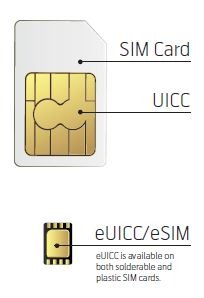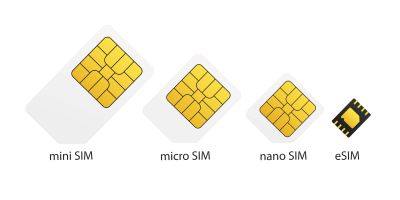Learn how embedded Universal Integrated Circuit Cards (eUICC) can support seamless connectivity across devices and networks. Download the white paper to understand how eUICC fits into modern IoT strategy and long-lifecycle deployments.
As the Internet of Things (IoT) continues to transform industries, demand for reliable and scalable connectivity is growing rapidly. eUICC has become a key enabler for international and large-scale IoT deployments, making it easier to manage operator profiles remotely and support devices across multiple markets.
This guide provides an overview of the technology, relevant industry standards and practical use cases, helping you assess where eUICC adds value and what to consider before adoption.
This white paper serves as a decision guide for organisations evaluating eUICC — outlining its benefits, limitations and key implementation factors.
The traditional SIM card has been a cornerstone of mobile telecommunications for decades, providing a secure method for identifying and authenticating users on mobile networks. In most cases, the roaming capabilities of SIM cards can meet not only the needs of mobile users, but IoT as well. Telenor IoT offers a roaming service that enables its customers to connect their IoT devices to cellular networks in over 200 countries and territories. The service includes a range of features designed to provide reliable and cost-effective connectivity for IoT devices, including:
However, there are some situations in which roaming is not an option and the traditional SIM card model is not well-suited to support the requirements of IoT devices.
Want to understand the bigger picture? Read our introduction to IoT SIM cards.
Historically, SIM cards could hold just one subscriber identity linked to a single service provider. One service provider can still provide access to several networks through roaming, but in order to switch service providers, the SIM card needs to be physically changed to a new SIM card with a different subscriber identity.
Physically exchanging SIM cards creates complexity for companies managing large fleets of devices, especially for international deployments, or if the SIM card is not easily accessible. For example, if a company wants to deploy devices in markets where permanent roaming is prohibited by regulation, such as in China and Brazil, that company will need multiple connectivity service providers. This means SIM cards from multiple service providers need to be managed in the supply chain. In cases like these, eUICC can be an alternative solution.
Anyone planning their IoT strategy today faces many technology-related decisions which will impact the long-term success of a product deployment. If, how, and when to adopt eUICC technology is one of these crucial choices.
With a history that goes back twenty years, Telenor Connexion have witnessed and stimulated a number of technological shifts in M2M and the Internet of Things. We hope sharing our insights into today’s technological and market trends will help you succeed with IoT in the long term.
The Embedded Universal Integrated Circuit Card (eUICC) is a reprogrammable SIM (Subscriber Identity Module) technology that enables changing the user Mobile Network Operator (MNO) profile of a device without changing the physical chip. Where roaming is not an option, this capability opens up such markets to global IoT companies in a more manageable way than physically changing the hardware within its devices.
Because the eUICC is reprogrammable, it can host several MNO profiles in its flash memory at the same time. The process of changing profiles also involves remote SIM provisioning (RSP) software. The hardware of the eUICC works with the RSP to carry out the process of changing profiles. However, only one profile can be active at a time, and the process of swapping networks can still take significant time and resources.

eUICC is an acronym that stands for Embedded Universal Integrated Circuit Card. It’s a component of a SIM card that enables switching Mobile Network Operators (MNOs) over-the-air.
The hardware used in mobile devices that contains SIM and/or USIM applications enabling access to GSM, UMTS/3G and LTE networks.
SIM stands for Subscriber Identity Module. Refers to the data containing a unique identifier which is stored on a UICC.
SIM card is the common name for the plastic card which holds a UICC.
Despite the drawbacks of eUICC, it can still be seen as a good insurance for large-scale IoT deployments, as it provides the flexibility to switch between different network providers and ensures connectivity in remote areas, ultimately increasing the reliability and resilience of IoT systems. Overall, eUICC is a useful technology for large-scale IoT deployments, remote management, and security. However, organizations should be aware of the limited flexibility, potential complexity and cost of implementation, as well as compatibility issues with mobile networks. That’s why in many cases, relying on established mobile roaming networks used in standard IoT and in eSIM can be a better solution.
Overall, Telenor IoT’s roaming offering provides a comprehensive solution for customers looking to deploy IoT devices globally, with features designed to ensure reliable connectivity, competitive pricing, and ease of management.
Definitions within the industry vary somewhat, but we perceive eSIM as a fixed SIM card that is embedded in a device, while eUICC is a programmable SIM card that allows for remote provisioning of multiple SIM profiles. eSIM can be both “embedded SIM” (formfactor MFF2) without RSP functionality or eSIM with RSP functionality. Depending on your requirements, we can offer our customers either eSIM (MFF2) without RSP and eSIM (MFF) with RSP.

Remote provisioning is what distinguishes eUICC from more common eSIM solutions, so it’s important to understand the definitions and terminology to know if eUICC is needed in a particular use case.
Provisioning is the process of attaching certificates and profiles to a UICC. A profile is a combination of file structure, data and applications.
The subscriber identity profile enables access to a specific operator network. The operational profile contains applications and credentials which allow the SIM to function on a network.
A manufacturer installs an initial operator profile known as the provisioning profile (or bootstrap). This profile allows the UICC or eUICC to connect to a mobile network. With an eUICC, that provisioning profile can later be changed remotely.
Roaming refers to the operation of a device on a particular mobile network using a SIM identity from a different network operator. Over the last 30 years this model has been proven and developed for mobile networks. Roaming can be offered regardless of UICC or eUICC.
There are multiple ways to provide coverage across different mobile networks. Roaming is in general the most straightforward and cost-efficient model.
However, for some markets and use cases, the established roaming model is not fit for purpose. For example, in countries where roaming is prohibited. In such use cases, eUICC-based solutions can enable switching to local SIM profile to adhere to regulations.
The GSMA (GSM Association) is a global trade organization that represents the interests of mobile network operators and other mobile industry players. The GSMA plays an important role in promoting standardization in the mobile industry by developing and maintaining technical specifications and guidelines that help to ensure interoperability, security, and reliability across different networks and devices.
In Q2, 2024, the GSMA is releasing a new specification that defines the profile structure and life cycle management of eSIMs and eUICCs.
This new standard, known as SGP.32, defines the technical specifications for managing and updating eSIM profiles over-the-air (OTA). This includes how profiles are identified, authenticated, and provisioned.
It also defines the structure of eSIM profiles, including the parameters required for network access, and the life cycle of eSIM profiles, including how they can be updated, deactivated, and deleted.
Overall, SGP.32 is an important specification that helps to ensure the interoperability and security of eSIM technology, making it easier for mobile network operators and their customers to manage eSIMs across different devices and networks. Contact us or the GSMA to learn more about the current status of the standardization process.
We provide everything you need to quickly deploy a connected product or solution that will deliver business value over the long term. Telenor IoT fully supports eUICC deployments, taking care of the commercial, technical and operational complexities related to the eUICC technology.
We offer our customers a “full stack” IoT services, from hardware to connectivity and data cloud management to software and app development. The eUICC technology is integrated in this stack of IoT managed services.
